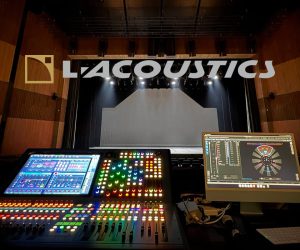
More Is More: Immersive Audio
Text:/ Christopher Holder
Thanks to L-Acoustics’ L-ISA and d&b’s Soundscape making headlines, it really feels like immersive audio’s time has come.
Immersive (or ‘spatial’) audio has been around a while. Ambisonics bubble of 3D sound was first in development in the ’70s for example. But now the conditions are right for immersive audio to take a leap forward into mainstream concert touring, AV events, audio installation, musical theatre, museum and exhibitions, and more.
Such is the flurry of activity it’s hard to separate what ‘immersive’ is and isn’t. Let’s break it down.
IMMERSIVE: 1 WORD, 2 PURPOSES
When we talk about immersive audio systems we’re talking about systems designed to potentially do two distinct jobs (and occasionally, they’ll do both).
The first is room enhancement.
The most famous of these systems is Meyer Sound’s Constellation, where scores of loudspeakers are carefully installed within a room, along with dozens of microphones that sniff the sounds in the space then reproduce them through the speakers to simulate a room with a different tonality or decay time than the natural reverberation. Constellation has been used to rescue concert halls with shoddy natural acoustics. Or it’s been used to supercharge presentation spaces.
OBJECT-BASED MIXING
The other aim of immersive audio systems is to improve upon stereo via object-based mixing. This is the rapidly emerging application which itself is manifest in two main formats: Frontal and 360.
Immersive frontal mixing sees the audio engineer sending instruments or stems to not less than five loudspeaker sources across the top of the stage.
360 mixing incorporates additional surround speakers — to the sides, rear and overhead.
As mentioned, object-based immersive mixing is, at its core, about addressing the shortcomings of stereo.
Stereo is great if you’re planted in the sweetspot — whether that be in your production studio’s Herman Miller or in a muddy festival field. Of course, in a gig situation a very small percentage of the audience is actually in the stereo sweetspot.
You can address this with more loudspeakers across the front, above the stage. And rather than placing your source via varying amplitude between the left and right speakers, you can now position that signal into the appropriate speaker between the left and right speakers. It means that no matter where you are in the room and the coverage area, the audio image remains true.
For 360° mixing, you can extrapolate from there, around and above the listening area.
BENEFITS OF IMMERSIVE
Forget about Pink Floyd cash registers going off behind you or THX-style glass shards flying overhead, most immersive productions will be ‘frontal’ with five arrays above the stage (additional arrays can be placed either side of the stage for additional width).
In these circumstances every patron in the listening area will be treated to a ‘what you see is what your hear’ audio image of the stage. Vocals are more intelligible. Every instrument is heard with more precision, the audio engineer isn’t so compelled to resort to a bag of EQ and compression tricks to achieve separation in a mix, while the extra ‘depth’ dimension can help to create lush and spectacular soundscapes.
RUBBER HITS THE ROAD
So how will immersive audio impact on the real world of AV events and installation?
We talk to big-event (and Emmy Award-winning) specialist Scott Willsallen about his audio design for a no-expense-spared UAE National Day celebration. With seven frontal arrays across an enormous stage, along with loudspeakers on the sides, rear and overhead, it’s safe to say this kind of approach will be the exception rather than the rule.
Most AV events will see immersive audio’s influence via the introduction of extra frontal arrays.
Saying that, aspirational concert halls would do well to consider a 360 system in their next upgrade. Sydney Opera House certainly did when it upgraded the Dame Joan Sutherland Theatre (regrettably that story will have to wait for a future issue).
Naturally, it all depends on the application and the budget. Which is why we’ve tackled this story from a number of angles. I trust it gives you a solid background in what is a rapidly emerging new audio paradigm.
THE PLAYERS
d&b Soundscape | dbaudio.com
d&b’s Soundscape tackles the 3D mixing and room enhancement challenges with two optional software packages: En-Scene (for 3D object-based sound placement) and En-Space (for acoustic manipulation and enhancement). Works with a DS100 64×64 engine.
L-Acoustics L-ISA | l-isa-immersive.com
Pronounced ‘El-lisa’, the French loudspeaker co. has a ‘road ready’ 3D mixing system. Not necessarily the most sophisticated interface but the easiest to jump into in a gigging scenario.
Meyer Sound Constellation
meyersound.com/product/constellation
Meyer’s mature acoustic enhancement system has rescued many a flawed performance space. Pricey, powerful and potentially life changing. Meyer is now turning its gaze to 3D mixing — it has the hardware, now it’s working on its SpaceMap UI to be more gig-friendly.
Harman Immersive | pro.harman
Uses a Lexicon-branded ‘QuantumLogic’ DSP to upscale a 5.1 or 7.1 source to a 32-channel immersive room. Pitched at movie theatres for the moment.
IOSONO | www.iosono-sound.com
Now a Barco company, IOSONO combines a ‘Core’ DSP and a GUI to achieve loudspeaker-agnostic object-based mixing. Pitched at cinemas, events and themed entertainment.
Vivace | www.mbbm-aso.com
A powerful hardware/software system for acoustic enhancement, in the main. Meyer Constellation’s main competitor. Big in the classical music/concert hall arena.
Astro Spatial Audio | astroaudio.eu
Another loudspeaker-agnostic system based on a rendering engine and a software GUI. Uses an algorithm developed by the Fraunhofer Institute. Making headway in the musical theatre market.
Outboard TiMax | outboard.co.uk
TiMax is one of the godfather’s of spatial audio. It’s best known for stage tracking vocal localisation — using a delay-matrix processor and software to dynamically move an actor’s vocal pan position across a LCR loudspeaker system.
Flux:: SPAT Revolution | fluxhome.com
Real-time 3D-audio mixing engine that can also add room effects. Can use it to send the result to a loudspeaker setup or a pair of normal stereophonic headphones, or export the result as audio stems to use in any other audio engine.















RESPONSES